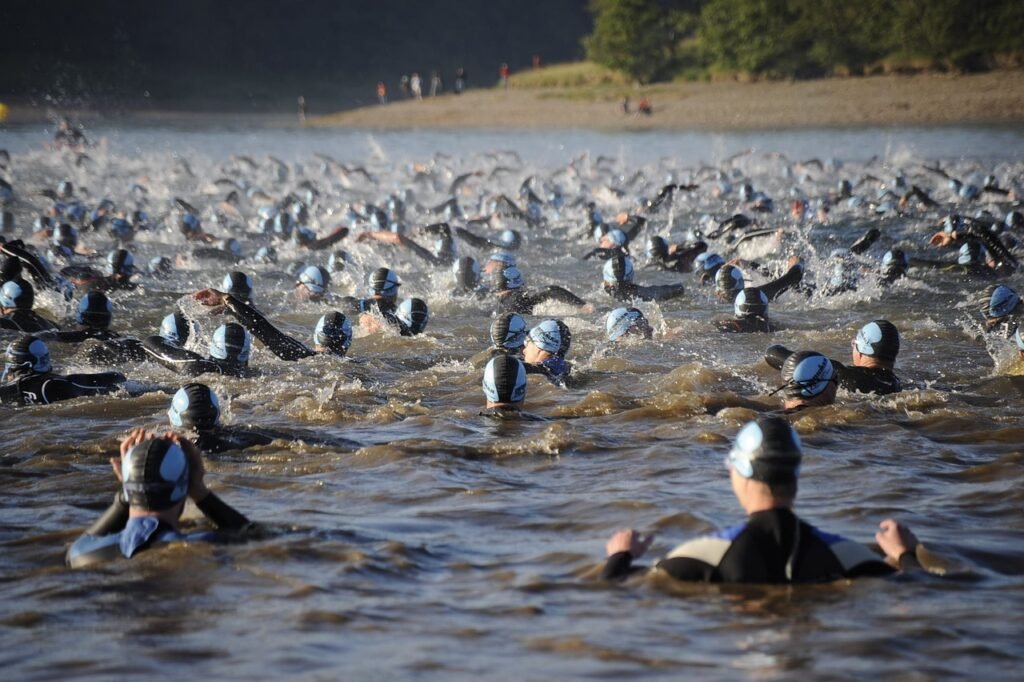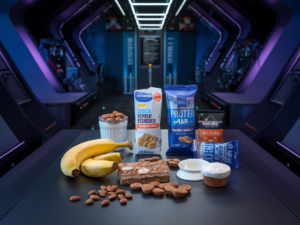Introduction: Understanding the Ironman Challenge
Hello dear readers,
Before we dive into today’s content, I want to share something important with you. Although I’m passionate about the topic we’re going to discuss and have spent a lot of time researching and learning about it, it’s essential to clarify that I am not a professional in the field.
What you will read next are insights and information that I have gathered based on my personal experience and self-taught studies. My intention is to start a conversation, share what I’ve discovered, and maybe help someone who is on the same journey of discovery. If you are an expert on the subject, your comments and guidance are very welcome, as we are all here to learn and grow together.
Now, let’s get to the good stuff!
The Ironman triathlon stands as one of the most grueling endurance events in the world, demanding a unique blend of physical prowess and mental fortitude. Originating in 1978 in Hawaii, the Ironman was conceived to determine the ultimate endurance athlete. It comprises three sequential disciplines: a 2.4-mile swim, a 112-mile bike ride, and a marathon 26.2-mile run. These distances alone underscore the monumental challenge participants face.
The Ironman triathlon is not just a test of physical endurance but also a trial of mental resilience. Athletes must endure hours of continuous exertion, pushing their bodies to the brink while maintaining focus and motivation. The preparation for such an event is as critical as the event itself. Proper training regimes, nutritional strategies, and mental conditioning are essential components for anyone aspiring to cross the finish line. Without these, the risk of injury and burnout significantly increases, dashing the hopes of even the most determined individuals.
Furthermore, the triathlon requires a holistic approach to training. Swimming, cycling, and running each demand different muscle groups and techniques. Therefore, a well-rounded training plan that addresses all aspects is crucial. Understanding the nuances of each discipline and how they interconnect can make a substantial difference in performance and safety.
As we delve into the 10 best ways to prepare yourself for an Ironman, it becomes clear why meticulous preparation is indispensable. From building endurance to mastering nutrition, each aspect plays a vital role in achieving success. Proper preparation not only enhances performance but also ensures that participants can undertake this formidable challenge safely and confidently.
Set Clear, Achievable Goals

Setting clear, achievable goals is fundamental for anyone preparing for an Ironman triathlon. The enormity of the challenge can be daunting, but by establishing realistic and specific goals, you can maintain focus and motivation throughout your training journey. Start by identifying your long-term objective, such as completing the Ironman within a certain timeframe. Once this overarching goal is defined, break it down into smaller, manageable milestones. For instance, you might aim to improve your swimming technique in the first month, increase your cycling endurance in the second, and enhance your running speed in the third.
These smaller milestones should be S.M.A.R.T.: Specific, Measurable, Achievable, Relevant, and Time-bound. For example, instead of setting a vague goal like “run faster,” aim for “reduce my 10K run time by 5 minutes in the next two months.” This specificity not only clarifies the target but also makes it easier to track progress. Use a training log or digital app to monitor daily workouts, distances, and times. Regularly reviewing this data allows you to see improvements, identify areas that need more focus, and adjust your training plan accordingly.
Staying motivated over the long haul is crucial. Celebrate small victories along the way to maintain enthusiasm. Whether it’s achieving a new personal best in swimming or completing a grueling bike ride, reward yourself with something enjoyable. Additionally, visualizing your success can be a powerful motivator. Picture yourself crossing the Ironman finish line and the sense of accomplishment that will follow.
Another effective strategy is to join a community of like-minded individuals. Training with a group or participating in online forums can provide support, encouragement, and accountability. Sharing your goals with others makes you more likely to stay committed and can offer valuable insights and advice from those who have already achieved what you’re striving for.
By setting clear, achievable goals and breaking them down into smaller, actionable steps, you can effectively prepare yourself for the rigorous demands of an Ironman triathlon. Stay focused, track your progress, and maintain your motivation to ensure you reach your ultimate objective.
Develop a Comprehensive Training Plan

Creating an effective training plan is crucial for anyone aiming to successfully complete an Ironman. A well-rounded plan should balance the three disciplines: swimming, cycling, and running. Each of these activities demands different sets of skills and endurance levels, making it essential to allocate time effectively to each. Incorporating periodization into your training is vital; this involves dividing your training into distinct phases, each with a specific focus, such as base building, intensity, and tapering before the race. This approach helps in systematically building up your stamina and strength while minimizing the risk of overtraining.
Rest days play a pivotal role in any Ironman training regimen. These days allow your muscles to recover, reducing the likelihood of injuries and ensuring sustained progress. It’s advisable to schedule at least one rest day per week, and also to listen to your body and take additional rest if needed. Gradually increasing the intensity of your workouts is another key component. Start with manageable distances and speeds, and progressively enhance them to align with your target performance levels. This gradual increase aids in adapting your body to the rigorous demands of the Ironman event.
Customizing your training plan to suit your current fitness level and personal schedule is also important. Assess your initial fitness condition and set realistic, incremental goals. If you are stronger in one discipline, allocate more time to your weaker areas while maintaining your strengths. Flexibility within your schedule is equally important; adapt your training sessions to fit into your daily routine without causing undue stress or fatigue. Utilizing training tools such as heart rate monitors, GPS devices, and performance tracking apps can provide valuable insights and help you fine-tune your plan.
Ultimately, a balanced and comprehensive training plan is the cornerstone of Ironman preparation. By focusing on periodization, rest, and individualized training strategies, you can optimize your performance and increase your chances of achieving your Ironman goals.
Focus on Proper Nutrition and Hydration
Nutrition and hydration are pivotal components in preparing for an Ironman. A well-structured diet supports endurance training and can significantly impact your performance on race day. To ensure optimal energy levels and recovery, it’s essential to balance your macronutrient intake—carbohydrates, proteins, and fats—in appropriate ratios. Typically, an endurance athlete’s diet should consist of approximately 55-65% carbohydrates, 15-25% protein, and 20-30% fats. Carbohydrates serve as the primary energy source, especially during longer training sessions, while proteins aid in muscle repair and recovery. Healthy fats contribute to sustained energy release and overall cellular health.
Meal timing is equally important. Consuming a balanced meal 2-3 hours before a workout can provide the necessary fuel, while a combination of protein and carbohydrates within 30 minutes post-training aids recovery. It is also advantageous to include small, nutrient-dense snacks between meals to maintain energy levels throughout the day.
Hydration strategies are critical for maintaining performance and preventing dehydration. Athletes should aim to consume water consistently throughout the day, with increased intake during training sessions. Electrolyte-rich drinks can be beneficial during long workouts to replace lost minerals, particularly sodium, potassium, and magnesium, which are crucial for muscle function and preventing cramps.
Experimenting with different nutrition plans during training is essential to identify what works best for your body. Individual responses to various foods and hydration strategies can vary, so it’s important to test and adjust your diet accordingly. Pay attention to how different foods affect your energy levels, digestion, and overall performance, and make adjustments to optimize your nutrition plan.
In conclusion, focusing on proper nutrition and hydration is vital for Ironman preparation. A balanced diet, strategic meal timing, and effective hydration practices can enhance endurance, promote recovery, and ensure peak performance on race day. By experimenting and fine-tuning your nutrition plan, you can determine the best approach to fuel your Ironman journey.
Invest in the Right Gear
Preparing for an Ironman requires not only rigorous training but also the right gear to support your journey. Investing in high-quality equipment can significantly enhance your performance and reduce the risk of injuries, ensuring you are well-prepared for the challenges ahead. The cornerstone of your gear should be a quality triathlon bike. A well-fitted bike can improve your cycling efficiency, comfort, and speed. It’s crucial to get a professional bike fitting to ensure that your bike suits your body dimensions perfectly, minimizing strain and maximizing power output.
Equally important is a good wetsuit, especially if the Ironman event includes an open water swim. A wetsuit designed for triathlons provides buoyancy, reduces drag, and conserves body heat, allowing you to swim faster and more comfortably. Make sure to choose a wetsuit that fits snugly without restricting your movement.
Running shoes are another essential piece of gear. Proper running shoes should provide adequate support, cushioning, and stability tailored to your running style and foot type. It’s advisable to visit a specialty running store where experts can analyze your gait and recommend the best options. High-quality shoes can prevent injuries such as shin splints, plantar fasciitis, and stress fractures, which are common in long-distance running.
Other accessories to consider include a triathlon-specific race suit, which offers moisture-wicking properties and reduces chafing during transitions. A good pair of sunglasses can protect your eyes from UV rays and enhance visibility, while a reliable GPS watch can help you monitor your pace and performance metrics.
Ultimately, investing in the right gear is not just about having the latest and most expensive equipment; it’s about ensuring that every piece you use is suited to your needs and enhances your overall performance. A well-prepared athlete equipped with the right gear is better positioned to face the grueling demands of an Ironman triathlon, making the investment worthwhile.
Incorporate Strength and Flexibility Training
Incorporating strength and flexibility training into your Ironman preparation can significantly enhance your performance and prevent injuries. While endurance training forms the core of Ironman preparation, neglecting strength and flexibility can leave you vulnerable to muscle imbalances and overuse injuries. Integrating a balanced strength training regimen ensures that your body remains resilient and capable of sustaining prolonged physical exertion.
Effective strength exercises should target key muscle groups that play a crucial role in swimming, cycling, and running. For instance, squats and lunges are excellent for building lower body strength, essential for the cycling and running segments. Upper body exercises such as push-ups and pull-ups improve the muscular endurance needed for the swimming portion. Core exercises like planks and Russian twists help stabilize the torso, thus enhancing overall balance and reducing the risk of injury.
Flexibility exercises are equally important in preparing for an Ironman. Stretching routines, particularly dynamic stretches before workouts and static stretches post-exercise, can improve muscle elasticity and joint range of motion. Yoga, with its emphasis on flexibility and mindfulness, can be particularly beneficial. Not only does it promote muscular flexibility, but it also fosters mental clarity and relaxation, crucial for the grueling demands of Ironman training.
Regular stretching and yoga sessions can also expedite recovery, allowing you to maintain a consistent training schedule. These activities help reduce muscle soreness, alleviate stiffness, and improve circulation, all of which are vital for sustained athletic performance. Incorporating strength and flexibility training into your Ironman regimen creates a balanced approach, enhancing endurance, preventing injuries, and promoting overall well-being.
Practice Mental Toughness
Competing in an Ironman triathlon is not solely a physical endeavor; it is equally a test of mental endurance. The grueling nature of the event, which comprises a 2.4-mile swim, a 112-mile bike ride, and a 26.2-mile run, demands immense mental toughness. Preparation for such a challenge includes training the mind to withstand fatigue, pain, and moments of doubt that inevitably arise during the race.
One effective technique for building mental resilience is visualization. By mentally rehearsing the race, athletes can prepare themselves for various scenarios, including adverse weather conditions, unexpected setbacks, and the physical strain of the event. Visualization helps in creating a mental blueprint of success, enabling athletes to navigate challenges with confidence and composure.
Positive self-talk is another powerful tool. During training and the race, maintaining a positive internal dialogue can significantly impact performance. Phrases such as “I am strong,” “I can do this,” and “Keep pushing forward” can help athletes stay motivated and focused. These affirmations counteract negative thoughts and reinforce a belief in one’s abilities.
Mindfulness practices also play a crucial role in mental preparation. Techniques such as meditation and deep breathing exercises help athletes stay present and manage stress. By cultivating a mindful approach, athletes can better handle the physical and emotional demands of the Ironman, maintaining clarity and calmness throughout the race.
Experienced Ironman athletes often share stories of overcoming mental barriers. For instance, Chrissie Wellington, a four-time Ironman World Champion, emphasizes the importance of embracing discomfort and viewing it as an opportunity for growth. Her approach includes breaking the race into manageable segments and celebrating small victories along the way.
Incorporating these mental toughness strategies into your training regimen is essential for success in an Ironman triathlon. By honing mental resilience, athletes can enhance their performance and achieve their Ironman goals with greater confidence and determination.
Simulate Race Conditions

Preparing for an Ironman requires more than just building endurance and strength; it necessitates familiarity with race day dynamics. One of the best ways to ready yourself is to simulate race conditions during your training. Integrating brick workouts, where you transition between two disciplines, is essential. For instance, practicing a bike-to-run transition helps condition your muscles to the sudden switch and reduces the shock that can happen on race day. These brick sessions should be a staple in your regimen, as they enable you to rehearse the physical and mental aspects of transitions.
Long-distance sessions that closely mirror race conditions are also invaluable. These sessions should include not just the physical demands but also the logistical elements of race day. Practice wearing the same gear you plan to use, including wetsuits, cycling shoes, and running attire. Familiarize yourself with nutrition plans, ensuring you know exactly how much and when to consume food and hydration. This is critical for avoiding gastrointestinal issues and maintaining energy levels throughout the event.
Managing transitions smoothly is another key component of race day preparation. Set up your transition area at home or in a training environment, practicing the quick changes between swimming, cycling, and running. Time yourself during these transitions to identify areas for improvement. Lay out your equipment in the same order you will on race day, and rehearse each step until it becomes second nature.
Finally, consider the logistics of race day itself. This includes knowing the course, understanding where aid stations are located, and planning for any environmental factors like weather or terrain. Incorporate these elements into your long-distance sessions to ensure you’re fully prepared for the demands of an Ironman. By simulating race conditions, you enhance not only your physical readiness but also your confidence, making race day a seamless and successful experience.
Plan for Recovery and Injury Prevention
Recovery is a crucial aspect of any Ironman training program. It ensures that your body can adapt to the rigorous demands of the training regimen, thereby enhancing performance and reducing the risk of injuries. Proper recovery should be an integral part of your training plan, addressing both immediate post-workout needs and long-term physical well-being.
One of the most effective strategies for recovery is ensuring adequate sleep. Aim for 7-9 hours of quality sleep per night to allow your muscles to repair and your body to rejuvenate. Sleep is a natural recovery tool that supports both physical and mental health, making it a non-negotiable component of your preparation.
Incorporating active recovery days into your training schedule is also essential. These days involve light activities such as yoga, stretching, or easy cycling, which help maintain blood flow and muscle flexibility without taxing your body. Active recovery prevents stiffness and promotes quicker healing of minor strains and fatigue.
Utilization of recovery tools like foam rollers and massage can significantly aid in muscle recovery. Foam rolling helps release muscle tightness and improve blood circulation, while regular massages can alleviate muscle tension and stress. These tools are beneficial for maintaining muscle health and preventing injuries.
Common injuries in triathlon training include tendonitis, stress fractures, and muscle strains. Preventative measures are crucial to avoid these setbacks. Proper technique in swimming, cycling, and running can reduce unnecessary strain on your muscles and joints. For instance, ensuring a balanced stroke in swimming or maintaining an appropriate cadence in cycling can prevent overuse injuries.
Listening to your body is perhaps the most critical aspect of injury prevention. Pay attention to signs of overtraining, such as persistent fatigue, soreness, or decreased performance. Adjust your training intensity and volume accordingly to avoid pushing your body beyond its limits.
By prioritizing recovery and implementing injury prevention strategies, you can sustain a robust and effective training regimen for your Ironman, ultimately ensuring that you reach the starting line in peak condition.
Conclusion: Embrace the Journey and Celebrate the Achievement
As you embark on the rigorous path of preparing for an Ironman, it’s crucial to remember that the journey is just as significant as the race itself. Thorough preparation, encompassing physical conditioning, mental resilience, nutrition, and strategic planning, forms the cornerstone of a successful Ironman experience. Each training session, dietary adjustment, and mental fortification step brings you closer to the finish line, reinforcing the fundamental attributes of discipline and perseverance.
Reflect on the key points discussed: from structuring a balanced training plan to incorporating strength workouts, managing nutrition, and ensuring adequate rest and recovery. These elements are not merely checkpoints but integral parts of a holistic approach to triathlon training. Embrace the small victories along the way, whether it’s running faster, swimming more efficiently, or fine-tuning your biking skills. These incremental improvements are milestones that signify your growing competence and readiness.
Moreover, the importance of mental preparation cannot be overstressed. Building mental toughness and resilience will enable you to push through the inevitable challenges that come with such a strenuous endeavor. Visualization techniques, staying positive, and setting realistic goals are essential strategies in maintaining motivation and focus.
On race day, remember that completing an Ironman is a monumental achievement, regardless of your finishing time. It reflects your dedication, hard work, and the ability to overcome physical and mental hurdles. Celebrate this accomplishment wholeheartedly. The experience of participating in an Ironman is transformative, offering profound insights into your capabilities and potential.
So, as you gear up for this journey, cherish each moment, appreciate your progress, and honor your commitment. The Ironman is not just a race; it’s a testament to your resilience, growth, and unwavering spirit. Embrace it fully, and let the finish line be a celebration of your remarkable journey.









